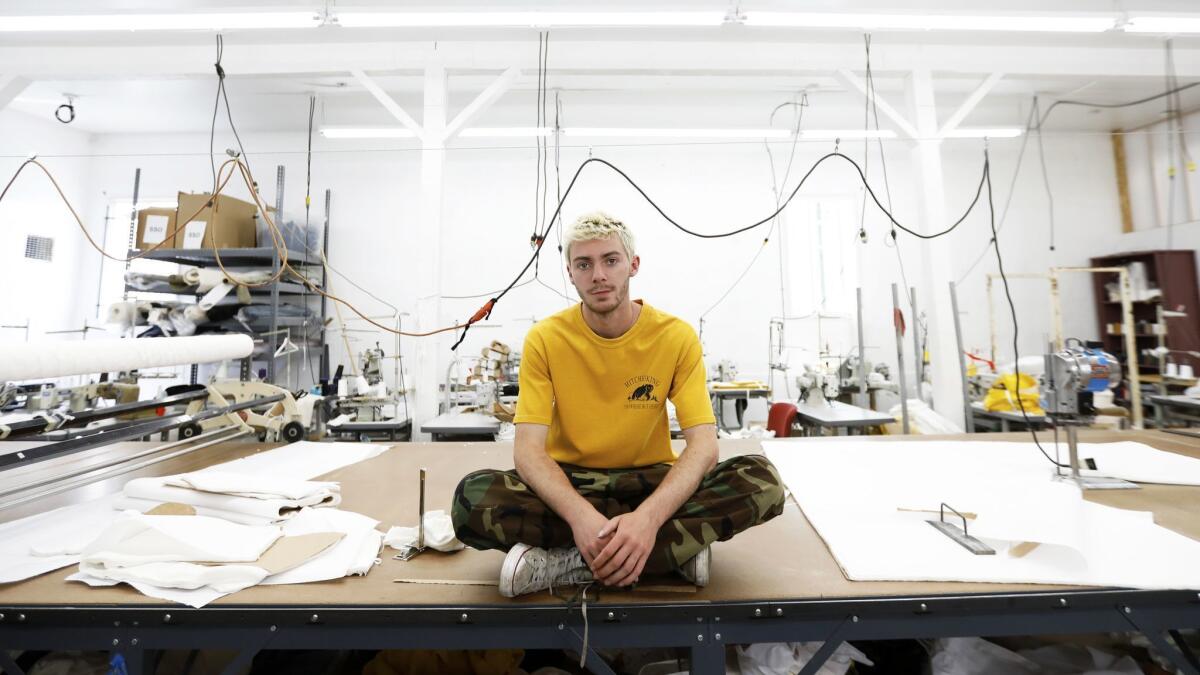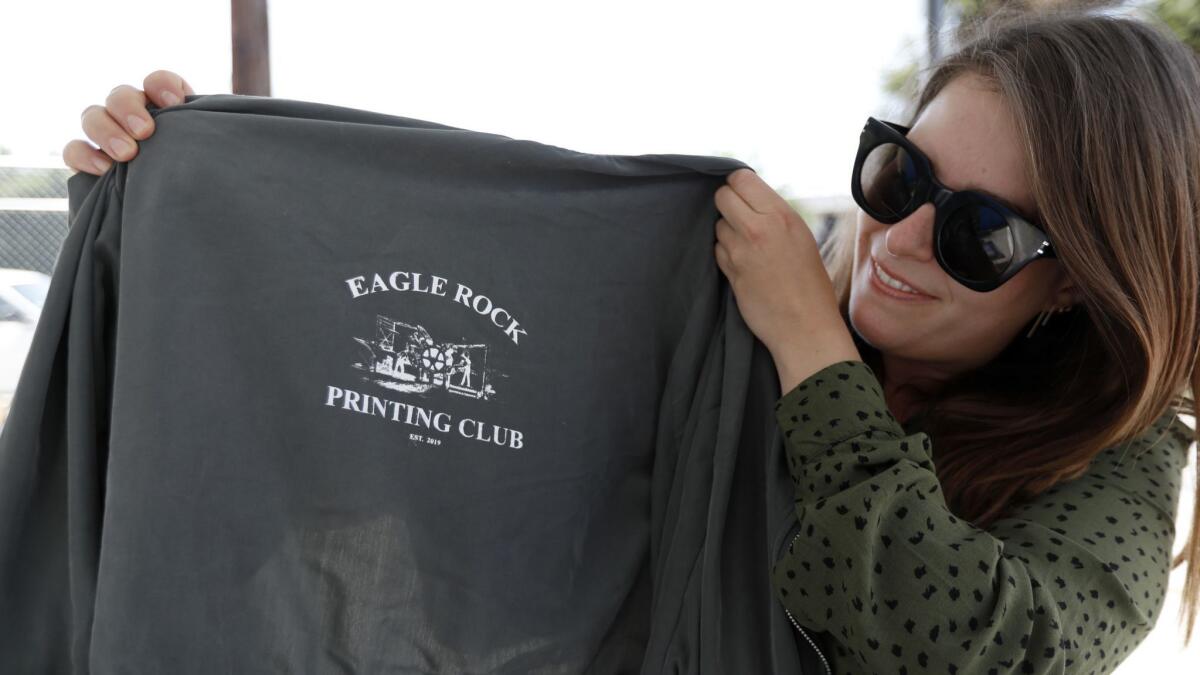Reese Cooper is designing tomorrow’s heritage brand today

The gritty stretch of Eagle Rock Boulevard with its nondescript industrial buildings, faded signage and acres of chain-link fencing seems an unlikely place to find one of fashion’s fastest-rising stars silk-screening T-shirts for strangers in a parking lot. Then again, Reese Cooper is about as unlikely as they come. At age 21, the London-to-L.A. transplant, who has a handful of collections under his belt, has goods on the shelves of U.K.-based retailer Selfridges as well as Barneys New York, the latter of which will be the exclusive retailer of his inaugural fall and winter 2019 women’s collection.
Cooper’s path to this parking lot — and his fashion label — began with a Bathing Ape T-shirt.
“I was living in London and I was about 14 or 15,” he said. “And it was this super-bright, vibrant camo [print], and I just had no idea what it was. But I was super-attracted to it. I found out there was a store not 5 miles from me, so I ended up just hanging out there.” Cooper’s stint there as an intern ended up profoundly shaping his career.
“The one thing I took away from that [was an understanding of] why things cost so much,” he said. “When I was around clothes all day, steaming them and making them look nice, I was able to ask, ‘OK, how this is different from that?’ I could see that one piece had a custom zipper pull that made it more expensive than another. I put all these little pieces together over three or four months and started to get interested in how to do that, how to add value to something.”
That dovetailed neatly with his natural affinity for tinkering and building. “I made skateboard ramps before I made clothes,” he said, adding that he’d also made the furniture that filled his atelier, including large work tables and a multi-drawer pattern case. “And I realized that I could either spend $1,000 on a jacket that was almost what I wanted or spend the time — and damn near the same amount of money — to figure out how make one that was exactly what I wanted.”
The first item of clothing he made was a pair of pants. “I found a really weird plaid at a fabric market in Shepherd’s Bush and brought it to a seamstress and said I wanted to make a pair of pants,” he said. “And she asked me where the pattern was. I was like, ‘What the hell is a pattern?’” He kept asking the seamstresses questions — and getting answers — and learned how to make clothes in the process.
In 2016, at the urging of his friend Charlie Giannetti (who would eventually open the Giannetti Factory space in L.A.’s Glassell Park neighborhood where the label is produced), Cooper moved to L.A. to launch his label — but only after convincing his mother. “It took some hard convincing,” he said, “but my mom was super-down for it once I showed her that I had a plan, and we agreed I’d try it for a year.” His London-based mother, a lawyer by trade, is the label’s only other official employee, serving as its chief executive and handling the finances. The rest of the work, from pattern-making to cutting and sewing, is done by the team in Giannetti’s employ.
In November 2016, when he was just 18, Cooper released his first capsule collection, which consisted of a few T-shirts and jackets, a hoodie, a sweater and a pair of pants. Called Spoiled Children, the collection was inspired by the kids he grew up with. The follow-up capsule, Seneca Arts Club, was similarly autobiographical. “The theme of that collection was basically that I didn’t go to school for this,” he said. “So I wanted something that represented the college of not going to college.”
His successive collections followed in the autobiographical, storytelling theme, a mix of collegiate nostalgia, Americana and work-wear influences that were his DIY responses to the world around him. “I guess all the academic references come subconsciously from the fact that I didn’t go to [college],” he said, adding that living abroad for his formative years may be one reason he’s so fond of heritage American work-wear motifs. (He was born in Jacksonville, Fla., and then lived in Atlanta until moving to London at age 11.) And, although he doesn’t consider himself an “L.A. brand” (“That sounds like palm trees, motorcycles and sunglasses,” he said. “I’m a brand that happens to be based in L.A.”), his work often keys into Southern California locales.
This is readily apparent in what Cooper considers his first complete menswear offering, the fall and winter 2018 collection that hit retail in June 2018. Themed around — and named after — the Owens Valley town of Lone Pine, it’s a wistful work-wear meditation on small-town isolation by way of slub cotton T-shirts (retail price $146) and heavyweight French terry hoodies ($312) screen-printed with log-cabin floor plans or the latitude and longitude of the community, as well as sturdy cotton twill work pants and work jackets ($336 and $648 respectively).
The collegiate vibe comes by way of varsity jackets that look as if they’ve been spliced together from two different garments, forest-green wool on the left and navy blue on the right ($1,180); and intarsia knit sweaters ($588) with the words “Lone Pine” arching across the front, though barely above the belt line instead of across the chest. (Actor and DJ Idris Elba has been spotted wearing one of the Lone Pine sweaters, and singer Nick Jonas recently stepped out in a varsity jacket from the pre-fall 2019 Against the Wind collection.)
Cooper called the follow-up spring and summer 2019 Fever Dream line “a kind of weird pastel-colored freakout moment” that reflected his mind-set as the label started to take off. Button-front linen shirts and suede trucker jackets joined the mix, and imagery included maps and hand-scribbled marginalia. (In the collection lookbook, a model stands in a parking lot wearing various looks as a makeshift office is assembled around him, piece by piece, one photo at a time.)

That storytelling element helps Cooper and his work stand out, said Julien Decanali, the Barneys New York men’s buyer who locked the retailer up as the exclusive stockist of Cooper’s pre-fall 2019 men’s collection. “He’s got a very fresh perspective, and I really enjoy not only the way he approaches the product but also that he cares deeply about the imagery behind it,” Decanali said, citing the aforementioned lookbook. “Frame by frame, there’s a [room] being built around [the model], literally walling him in. I thought that was really exciting.”
Decanali points to two other things that make Cooper unique. One is his age. “He’s only 21 years old, which is absolutely bananas to me. … A lot of what we see is really derivative when it comes to younger [designers’] collections, and there’s nothing about [Cooper’s] collections that feels derivative,” he said. “This feels genuine.” The other is the way Cooper engages with fans — and potential customers — through hands-on events in the factory parking lot.
“What he’s doing personally — with those arts and crafts days — is pretty genius,” Decanali said. “He’s taking the product and bringing people into it, making it much more social and engaging. He’s not even trying to make a buck. He’s doing it because it’s a cool thing to do with his client base.”
The event Decanali referred to is the occasional open house Cooper organizes to demonstrate techniques like tie-dying and screen-printing — using items of clothing people bring to be up-cycled — often accompanied by a guest artist. That’s why, on a sunny Saturday afternoon earlier this month, Cooper could be found in the parking lot of the Giannetti Factory pulling prints onto the T-shirts, trousers and tote bags handed to him by friends and fans, while Akron, Ohio-based artist Clayborne B. Bujorian offered up white-paint handprints.

Alexandra Bolinder-Gibsand, 29, a landscape designer from Los Feliz who had discovered the event while walking by, had an “Eagle Rock Printing Club” graphic printed on the back of a jacket.
“I think [this is] absolutely amazing,” she said, “because when people get a chance to be part of the creative process, it creates a deeper connection with the designer, the work [and] the clothes. And, from an environmental standpoint, I think it’s a really creative way to breathe fresh air into something old.”
Harry Bernstein, 42, New York-based chief creative officer for advertising and branding firm Havas, first met Cooper years ago. He stopped by with a couple T-shirts after finding out about the event through social media.

“I like the up-cyling [element],” he said. “Really, how much stuff does the world need? And if you really think about it, what designers are doing is kind of taking designs and patterns from the ’60s, ’70s and ’80s and remaking them with their own logo on it. So [Cooper’s] just skipped that. He’s taking your [personal] belongings and putting his logo on it. It’s a very authentic, intimate connection.”
Bernstein likened Cooper to a designer who’s practically synonymous with the authentic Americana. “He’s the new Ralph Lauren,” he said. “He has a real American aesthetic that still feels contemporary. He does the work-wear thing, but it’s still wearable. And he also has a masculinity, but it’s balanced.”
Barneys’ Decanali acknowledged the Ralph Lauren comparison but points to another Lauren, Ralph’s artist-turned-designer nephew. “Another brand that comes to mind is Greg Lauren, who is sort of the champion of the DIY and rip-and-repair [aesthetic],” he said. “Greg has a little bit of a different sensibility, but it channels a lot of the same emotions.”

21-year-old designer Reese Cooper has his finger on the pulse of American streetwear.
When asked about similar labels in his orbit, Cooper excitedly brandished his cellphone and pulled up a photo. “When they put my clothes in Barneys Madison Avenue store, they put me right next to Double RL,” he said. “That was a cool thing for me, because that’s a brand that I’m very inspired by.”
With his expansion into women’s clothing, set to hit Barneys in September , Cooper said he’s experimenting with new silhouettes, fabrics and techniques — building out his world with hands-on DIY determination. In the coming months and years, there’s a good chance you’ll hear Cooper’s name, but don’t expect to see it splashed across the front of his clothes. It’s something he takes great pains to avoid. “I’m not Calvin Klein. I have no interest in branding myself like that,” he said, referring to the designer name that graces underwear waistbands around the globe. “I’m cool to wear the name Carhartt, because it’s a hundred-year-old heritage brand. Obviously, I’m the person behind my label, but I don’t need to share it with the world. You don’t need to wear my name on your shirt. If people want that, it’ll happen in 50 years from now when I’m not in charge of it any more.”
Given the label’s early successes, not to mention his considerable skill as a designer and storyteller, imagining Reese Cooper as a heritage brand circa 2069 isn’t the least bit unlikely.
For more musings on all things fashion and style, follow me at @ARTschorn




